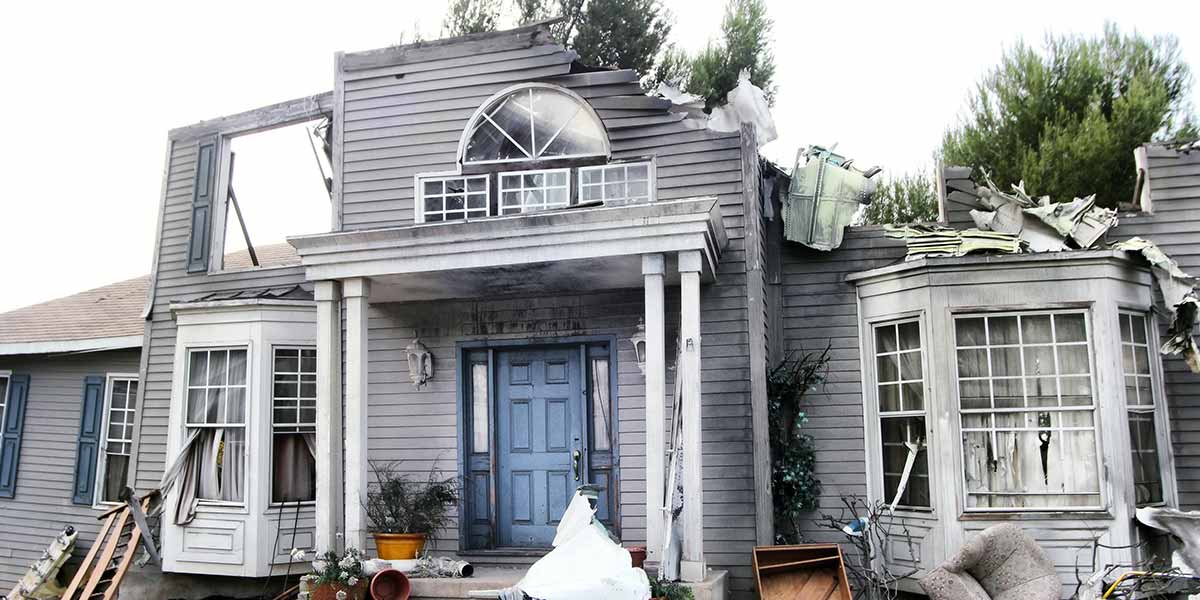
You never expect it to happen to you, but when a disaster strikes, it can be a time of stress, frustration and, most of all, confusion. It’s tough to know what steps you need to take after a natural disaster impacts your life. That’s where our guide comes in. From steps to take in the immediate aftermath of the disaster to guidelines on how to start cleanup, we’ll walk you through this difficult time to help you find the light at the end.
Steps to Take After a Disaster
What Type of Disaster Are You Cleaning Up?
The first section of this guide is going to help you make sure things are moving in the right direction in the immediate aftermath of the damage. If you’re ready to start the cleanup phase, click one of the jump links above to get to advice for specific damage types. Otherwise, read on for guidance from FEMA, State Farm and the Insurance Information Institute to help lead you on the road to recovery.
Once you know everyone is safe and sound — including your pets — it’s time to get on the phone and call your insurance company. In fact, that call should be one of the few calls you make.

“Send text messages or use social media to contact friends and family — make calls only in an emergency to conserve battery life.”
State Farm
While your insurance agency will ask a lot of questions, dealing with insurance companies during a disaster isn’t hard as long as you answer the questions to the best of your ability.
When you call, provide your policy number. Don’t worry if you don’t have it because they should be able to find your account with your phone number and a few security questions. The reason your agency needs this is two-fold: it lets them log the information in your account and lets them see what coverage you have in order to give you the most accurate information possible.
According to a State Farm spokesperson, “Today’s homeowner’s policies provide protection against a number of the perils of modern life in one ‘package’ policy.” Typically, a policy will cover your home, other structures on your property, personal property, loss of use or additional living expense, personal liability and medical payment. However, there are limitations and exclusions that may apply.
Once your insurer has accessed your account, they will ask what happened and when it occurred to get some general background information. The next step in the insurance claims process involves reviewing the details of the property damage. Don’t panic if you don’t cover everything at once. Your insurer understands that you are going through a trying time and doesn’t want to make things any harder. They are simply trying to get enough preliminary information to get the claim process started. Just do your best to give detailed and truthful answers.
After you’ve answered all of the questions, it’s your turn to get some information. Loretta Worters with the Insurance Information Institute provided some questions you should ask.
Don’t get off the phone until you know the answers to these questions:

“Contact your insurance company as soon as it is safe to do so. While an insurer will usually handle the most serious claims first, the sooner you start the process, the faster the claim can be settled.”
Loretta Worters | Vice President of Media Relations, Insurance Information Institute
While your instincts may be to immediately try and save your belongings, ensure it is safe to do so first. Some tell-tale signs that you don’t want to be in a room after a disaster include:
Pro Tip: Keep in mind that the structure of your home can change fast. If you enter the building, you’ll want to continually be aware of issues and be ready to leave at a moment’s notice.
FEMA suggests that you wait to enter the building if you have any concerns: “If you have any doubts about safety, have your residence inspected by a qualified building inspector or structural engineer before entering.”
Another thing to watch out for is wildlife. According to FEMA, it’s not uncommon for animals to take shelter in homes during and after a disaster. However, approaching them might not be a good idea, as they will be scared and more prone to unpredictable action.
If you are unable to return to your home, Worters said you should let your insurance company know as a temporary living situation will most likely be covered by your policy. “Your homeowners or renters’ policy will reimburse you for additional living expenses such as a hotel, meals, even boarding your pet,” Worters said. “If you need to find other accommodations while your home is being repaired, keep records of your expenses.”
This step may not always be needed, but you should always be aware of it. If your home has been damaged, but you feel it’s safe to re-enter, the first thing you should do is shut off electric, gas and water to your home.
Why is it important to shut these connections off? If you don’t, more damage could happen to your home even if the natural disaster has passed. For example, you may have had a gas line severed without knowing it. If the gas is freely running, one spark could result in a fire or explosion.
Most of the time, the master shutoff valve for your utilities are with the meter. If your meters are outside, this step can be done easily enough. If they are inside, they are often found in the basement or with the hot water tank and furnace.
Remember you won’t be able to salvage everything — you’ll need to prioritize what is most important to save. Whether it’s because the item is too damaged or you don’t have enough storage room available to house the displaced items, be ready to make some tough decisions in a short time span.
Consider these questions to help you prioritize which items to save:
This is going to be a tough step. Not because the act of taking photos is tough, but because you’ll need to fully realize the scope of the damage. However, this step must be done thoroughly, regardless of if you plan on using insurance or handling it all yourself.
Take photos of the structural damage as well as pictures of any items that were impacted before you start any disaster cleanup. Multiple views will help the insurance company get a 360-degree of the damage, allowing them to fully understand the extent of the damage. It’s also helpful to have an abundance of photos in case a representative from the insurance company can’t make it to your home until after repairs have started.

“To assist with the insurance claim process, be sure to document and photograph everything. Photograph the items to make a room-by-room inventory of missing or damaged goods.”
State Farm
If you don’t plan on involving insurance, having photos will still be useful as you replace items. It will give you a reference to look at as you try and find a similar product to what you had lost.
If there is something simple you can do to help stop further damage, do it. Just make sure it’s nothing too big. If you lost some shingles and water is leaking into your attic, get on the roof — provided it’s safe to do so — and nail a tarp over the damage. Patch a hole in the wall with a plywood board. Dry out the basement after it flooded.
The thing to keep in mind is that the repairs you make at this point should only be to prevent further damage from happening. Any substantial repairs should wait until an insurance adjuster has been out to assess the damage or your insurer has given you permission to move forward.

“Take reasonable steps to protect your property from further damage. Save receipts for what you spend and submit them to your insurance company for reimbursement. Remember that payments for temporary repairs are part of the total settlement.”
Loretta Worters | Vice President of Media Relations, Insurance Information Institute
All that’s left is to start cleaning. While the section below will go in-depth on how to clean various damage types, there are a few things you will need to do regardless of the disaster:
Unfortunately, when it comes to cleaning up after a natural disaster, it’s not as simple as just following a set of directions. Often times, there are a number of different damage types that need to be cleaned. For example, if a strong storm blows a tree onto your home, you’ll not only have to clean up the damage from the tree, but also any water that got inside the home as a result in addition to other wind damage.
Read on to find our detailed guides to clean up after water, fire, wind and general property damage.

Whether you experienced a flood, burst pipe or roof leaks during a storm, water damage can happen quick. Follow these steps to clean up the mess.
Get more detailed cleaning instructions in our step-by-step Guide to Cleaning Up After a Flood

Fire damage is one of the most invasive issues to a structure. Not only is there the potential for structural damage, but you’ll also need to remove soot and ash while trying to get any smoke smells out of furniture and the walls. It’s a process, but it’s entirely possible to get your home back to normal with a bit of work.
Get more detailed cleaning instructions in our comprehensive Guide to Cleaning Up After a Fire

From broken windows to lost shingles or siding panels, wind damage can cause various kinds of damage to your home. As a result, it’s an issue that requires a thorough examination to ensure you find all of the issues in order to start the cleanup process.

Cleaning your home after a natural disaster is one thing. Taking care of and repairing your lawn, landscaping and other property structures is a whole different issue. That’s because the cleanup can be as simple as picking up branches and minor fence repair to removing knocked down trees and repairing the foundation of your shed. From the big issues to the little ones, here are the steps to clean up your property:
It’s easy to get weighed down by the stress and frustration that comes with a natural disaster — and that’s a perfectly natural reaction. Just remember the most important thing is that you and your loved ones are together. With people there to support you, you’ll get through this and find an even brighter future.
We’re here to help during this difficult time. If you need a dumpster to clean up, give our team a call so we can help you move forward and get your home on the mend.